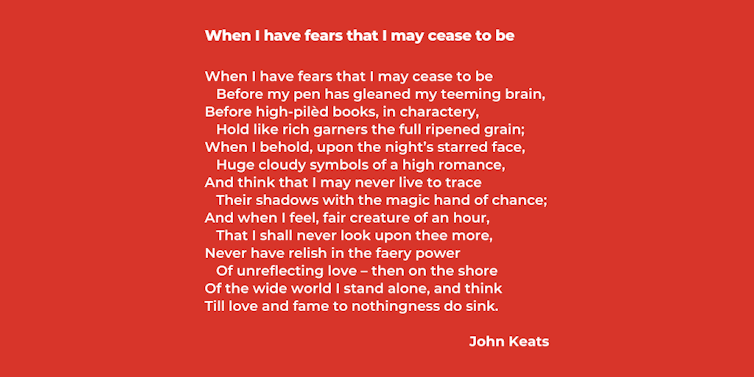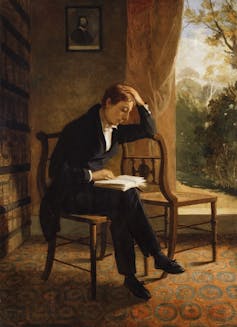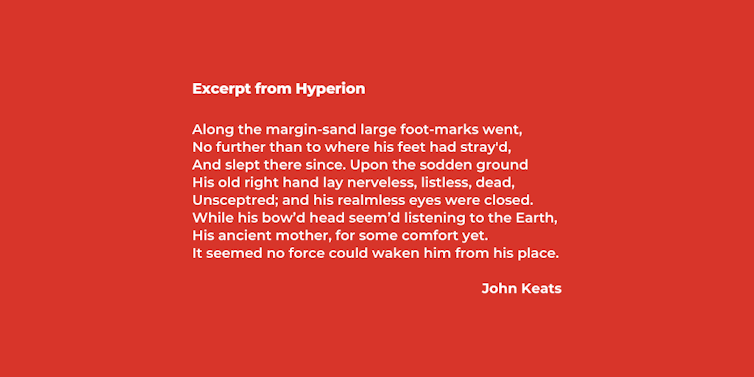John Keats: sut mae ei gerddi am farwolaeth ac ieuenctid coll yn taro deuddeg yng nghyfnod COVID-19

John Keats gan Joseph Severn (1819). Yr Oriel Bortreadau Genedlaethol
23 Chwefror 2021
Ar ddeucanmlwyddiant marwolaeth Keats, mae Athro Llenyddiaeth Saesneg, Richard Marggraf Turley, yn ysgrifennu yn The Conversation am sut y daeth Keats yn fardd ei gyfnod a hefyd yn fardd ein hoes ni:
In John Keats’ poems, death crops up 100 times more than the future, a word that appears just once in the entirety of his work. This might seem appropriate on the 200th anniversary of the death of Keats, who was popularly viewed as the young Romantic poet “half in love with easeful death”.
Death certainly touched Keats and his family. At the age of 14, he lost his mother to tuberculosis. In 1818, he nursed his younger brother Tom as he lay dying of the same disease.
After such experiences, when Ludolph, the hero of Keats’ tragedy, Otho the Great, imagines succumbing to “a bitter death, a suffocating death”, Keats knew what he was writing about. And then, aged just 25, on February 23 1821, Keats himself died of tuberculosis in Rome.
Life sliding by
His preoccupation with death doesn’t tell the whole story, however. In life, Keats was vivacious, funny, bawdy, pugnacious, poetically experimental, politically active, and above all forward-looking.
He was a young man in a hurry, eager to make a mark on the literary world; even if – as a trained doctor – he was all too conscious of the body’s vulnerability to mortal shocks. These two very different energies coalesce in one of his best loved poems, written in January 1818 when the poet was in the bloom of health:

When I Have Fears That I May Cease to Be is a poem of personal worry, according to biographer Nicholas Roe. In it, Keats is anxious that he won’t have time to achieve poetic fame or fall in “unreflecting love”, and these fears and self-doubts take him to the brink.
But as brinks go, this one doesn’t seem all that bad. The poem is romantic with a small “r” – wide-eyed, dramatic, sentimental – its vision of finality, of nothingness, gorgeous in its desolation, and all-importantly painless. Who can read those final lines without themselves feeling a pull to swooning death, half in love with it, as Keats professed to be?
That’s what I used to think, at any rate. Lately, in the pandemic, I’ve begun to read this poem rather differently. Lensed through long months of lockdown, the sonnet’s existential anxieties seem less abstract, grand and performative, and more, well, human.
It’s a poem that will resonate with the youth who are cooped up indoors, physically isolated, unable to meet and mingle, agonisingly aware of weeks slipping by, opportunities missed, disappointments mounting. This poem has made me almost painfully empathetic towards their plight.

The sonnet’s fears of a future laid to waste are shared by whole generations whose collective mental health is under siege. In his last surviving letter, written two years after the sonnet while dying in Rome, Keats records a “feeling of my real life having past”, a conviction that he was “leading a posthumous existence”. How many of us are experiencing similar thoughts at the moment?
Illness and isolation
Of all the Romantics, Keats perhaps knew most about mental suffering. He grew up in Moorgate, just across from Bethlem Hospital, which was known to London and the world as Bedlam. Before he turned to poetry, Keats trained at Guy’s hospital, London, where he not only witnessed first-hand the horrors of surgery in a pre-anaesthetic age but also tended to patients on what was called the lunatic ward.
It was all too much for him. Traumatised by the misery and pain he felt he could do little to alleviate, in 1816 he threw medicine in for the pen. His experiences at Guy’s, though, and the empathy he developed there, found their way into his writing. For instance, in Hyperion, his medical knowledge helps him to inhabit the catatonic state of “gray-hair’d Saturn”, who sits in solitude, “deep in the shady sadness of a vale”, despairing after being deposed by the Olympian gods. The vignette is a moving image of isolation and enervation that speaks to us today:

As for lockdown, Keats was no stranger to its pressures and deprivations. During periods of illness in Hampstead in 1819 – precursor symptoms of tuberculosis – he was reluctant to venture out, isolating himself. In October 1820, he set sail for Italy in the hope warmer climes would save his lungs. On arrival, his ship was put into strict quarantine for ten days. In letters to his friends, Keats described being “in a sort of desperation”, adding, “we cannot be created for this sort of suffering”.
Keats was a poet of his age, his own social, cultural and medical milieu. And yet, on the bicentenary of his death, he’s also – more than ever, perhaps – a poet of ours. A poet of lockdown, frustration, disappointment, fears … and even hope.
Because even in those last, scarcely imaginable weeks in Rome, 200 years ago, holed up in a little apartment at the foot of the Spanish Steps, he never quite gave up on the future, never relinquished his dreams of love and fame.![]()
Mae'r erthygl hon wedi ei hailgyhoeddi o The Conversation dan drwydded Creative Commons. Darllenwch yr erthygl wreiddiol.



